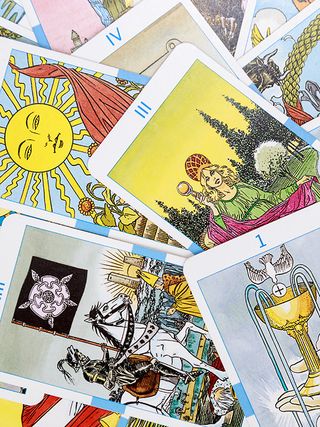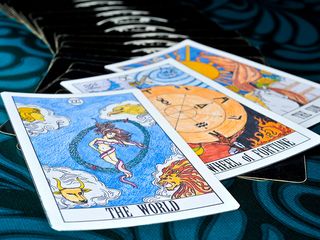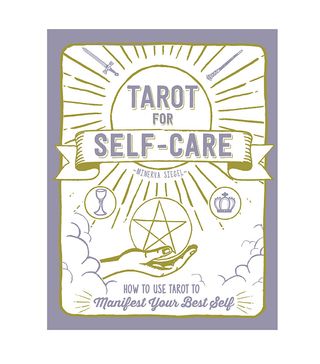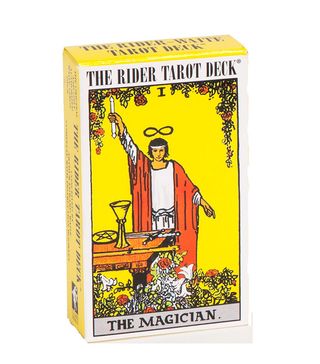Why You Should Add Tarot to Your Self-Care Routine

When you think of a tarot card reading, you might picture an old mysterious woman showing you cards (probably an ominous one) by candlelight, with a crystal ball next to her. Or you might picture a seedy storefront with a neon sign that says, "Psychic." In reality, though, tarot card readings don't always involve a dark room and predictions of death or dire circumstances. According to tarot enthusiasts and experts, you can use the practice to give you more personal insight and for personal growth.
In short, tarot can be a form of self-care and self-improvement. Author Minerva Siegel explores this idea in her new book, Tarot for Self-Care. In the introduction, she writes, "A marvelously versatile tool, tarot is much more than turning over cards in a deck; it can be used to exercise your intuitive muscles, analyze yourself in constructive ways, and learn your own potential."
The book is a how-to for tarot beginners and enthusiasts alike. Its first chapters are about how to set the scene for a tarot reading, interpret tarot, and shuffle and draw cards. In later chapters, Siegel provides self-care activities based on cards drawn, and how to use your readings for self-exploration and self-improvement. It's a holistic look at how tarot can support you, body and mind. Some self-care activities based on cards drawn include writing down goals in a daily planner or journal; practicing deep breathing, and evaluating your goals and intentions and what motivates you.
We got the chance to interview Siegel about her history with tarot and for more tips on how to use the ritual and practice as a form of self-care. See what she had to say below.
How did you get into tarot?
I grew up with a fascination with all things witchcraft. Blame the '90s Olsen twins film Double, Double, Toil and Trouble, if you will, but I've always been enamored by the ideas of magical talismans, old enchanted homes, fortune-telling cards, and fate written in the stars. As I grew, I honed that fascination into becoming a practitioner of non-religious witchcraft; and dabbling in all sorts of divination methods, including tarot, felt like a natural part of that.
How has tarot helped you in your own life?
Reading tarot has made me a more mindful, self-aware, considerate, and reflective person, and I'm so grateful for that.
What are some ways to get started? How do you prepare?
Many traditional tarot readers will tell you to make a big ceremony out of tarot reading, that it needs to be a sacred sort of production. While I do often incorporate tarot into my spells and witchcraft, I also think it's perfectly acceptable to pull a deck of cards from my purse over coffee with a friend. The main key to reading tarot is to do it in a way that resonates with you. If you need incense, candles, crystals, drawn drapes, sacred incantations, and certain herbs to open your third eye and achieve a connection with your cards, good on you! Do that. My way of approaching tarot is often a little more laid-back, but, I think, just as effective.
Are all tarot decks created the same? Do you have any recommendations?
There are really an endless variety of tarot decks. I recommend getting started with a 78-card tarot deck based on the Rider-Waite imagery. When you have a thorough understanding of that foundation, the world is your oyster! I have over 20 tarot decks in many different styles. Choose cards with artwork that resonates with you.
For beginners, how can they use tarot for their well-being?
Each of the 78 tarot cards in the Rider-Waite deck holds lessons and warnings for us, which can be applied to many different aspects of our lives. By approaching tarot with a self-care intent, it's easy to interpret the cards' guidance in ways that are beneficial to our well-being. Tarot can be a tool to help us look within our own subconscious. It can help us make decisions, reveal the true nature of a situation, and point out aspects of ourselves that need our attention and care.

How often should you use tarot as part of your self-care routine?
I recommend, quite simply, using tarot as part of your self-care routine as little or often as you wish. I find that if I try to set a strict tarot schedule, it starts to feel like a chore. However, when I pick up a deck of tarot cards intuitively or as needed, I find the whole process more enjoyable. I often read tarot every day, but I do have spells when I'll take a break, and go a week or so without picking up a deck.
When you use tarot for self-care, should it be mostly a solo venture? Or can you do it with friends?
Tarot can definitely be done with friends, if you'd like. Personally, I only do tarot with people whose energy I trust and enjoy. When I use tarot in a spiritual way, a sort of energetic link is formed between myself, the cards, and whoever I'm reading them with. I don't like to open up my energy to just anyone, so I'm selective about who I do readings with.
What can you do with a "bad" reading? Or a reading that is a bit ominous?
There are no truly negative cards in tarot. Some have warnings or more serious lessons, but they always have silver linings. Life isn't full of only love and light. Pretending that it is causes us to ignore all the shadowy bits that add depth to life. We have to acknowledge shadow in order to expose it, understand it, work with it, and grow from it. Shoving any unpleasantness under the rug doesn't do anyone any good long-term.
What do you think are some common misconceptions people have about tarot reading?
People often think that tarot eading is all about telling the future. They think it's a practice for mystics, à la Professor Trelawney from the Harry Potter books, or that it's very complex and difficult to get into. On the contrary, tarot has a great many uses that go far beyond predicting the future, and you don't have to be a traditional spiritualist clad in shawls and sitting in a heavily perfumed, dusty parlor to enjoy the benefits of tarot. My book, Tarot for Self-Care: How to Use Tarot to Manifest Your Best Self, is filled with tips and tricks to help beginners understand tarot and to help advanced practitioners see tarot through a modern, refreshing, insightful lens.
What would you say to skeptics?
Even if you don't choose to adopt a spiritual approach to reading tarot, the cards can be used to delve into your subconscious. They can act as mirrors, reflecting hidden truths, needs, worries, and dreams back at us, so we can acknowledge them and move forward with a better understanding of ourselves.
Next up: 15 Wellness Books That Will Change Your Body and Mind
Disclaimer
This article is provided for informational purposes only and is not intended to be used in the place of advice of your physician or other medical professionals. You should always consult with your doctor or healthcare provider first with any health-related questions.
Sarah is lifestyle writer and editor with over 10 years of experience covering health and wellness, interior design, food, beauty, and tech. Born and raised in Los Angeles, she attended New York University and lived in New York for 12 years before returning to L.A. in 2019.
In addition to her work on THE/THIRTY and Who What Wear, she held editor roles at Apartment Therapy, Real Simple, House Beautiful, Elle Decor, and The Bump (sister site of The Knot).
She has a passion for health and wellness, but she especially loves writing about mental health. Her self-care routine consists of five things: a good workout, “me” time on the regular, an intriguing book/podcast/playlist to unwind after a long day, naps, and decorating her home.
-
 I'm the "Wellness Girl" of My Group—30 Buys I'd Recommend to All My Friends
I'm the "Wellness Girl" of My Group—30 Buys I'd Recommend to All My FriendsFeel (and look) your best.
By Emma Walsh
-
 Ty Haney Prioritizes Moving Her Body in the Mornings—Here's Why You Should Too
Ty Haney Prioritizes Moving Her Body in the Mornings—Here's Why You Should TooShe calls it "changing the chemistry."
By Candice Aman
-
 How This Clean-Bodycare Founder and Mom Winds Down on the Weekends
How This Clean-Bodycare Founder and Mom Winds Down on the WeekendsCalm vibes only.
By Candice Aman
-
 I Want to Start Adding Healthier Products to My Routine—This Site Has It All
I Want to Start Adding Healthier Products to My Routine—This Site Has It AllMajor life hacks ahead.
By Aniyah Morinia
-
 The Founder of This California-Chic Brand Shares Her Restorative Evening Rituals
The Founder of This California-Chic Brand Shares Her Restorative Evening RitualsSimple, cozy, and luxurious.
By Candice Aman
-
 Body Positivity Influencer Alicia McCarvell Shares Her Feel-Good Night Routine
Body Positivity Influencer Alicia McCarvell Shares Her Feel-Good Night RoutineHer TikToks help to inspire and bring joy to her 2.8 million followers.
By Candice Aman
-
 WNBA Star Skylar Diggins-Smith Wants to Make Room for Mindfulness
WNBA Star Skylar Diggins-Smith Wants to Make Room for MindfulnessThe sports star shared her wellness routine with us.
By Sarah Yang
-
 These 17 Powerhouse Foods Will Protect Your Whole Body
These 17 Powerhouse Foods Will Protect Your Whole BodyAnd they're easy to add to your diet.
By Sarah Yang



